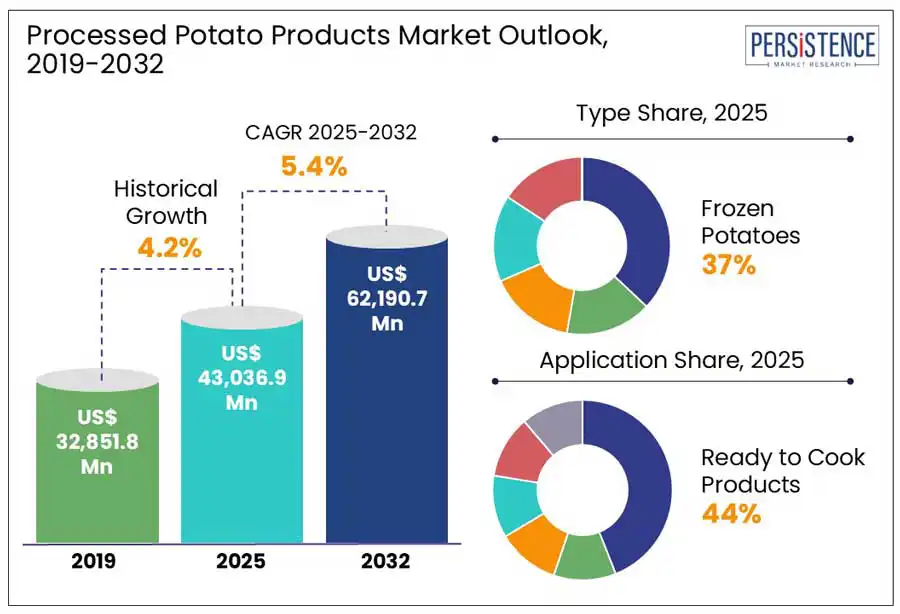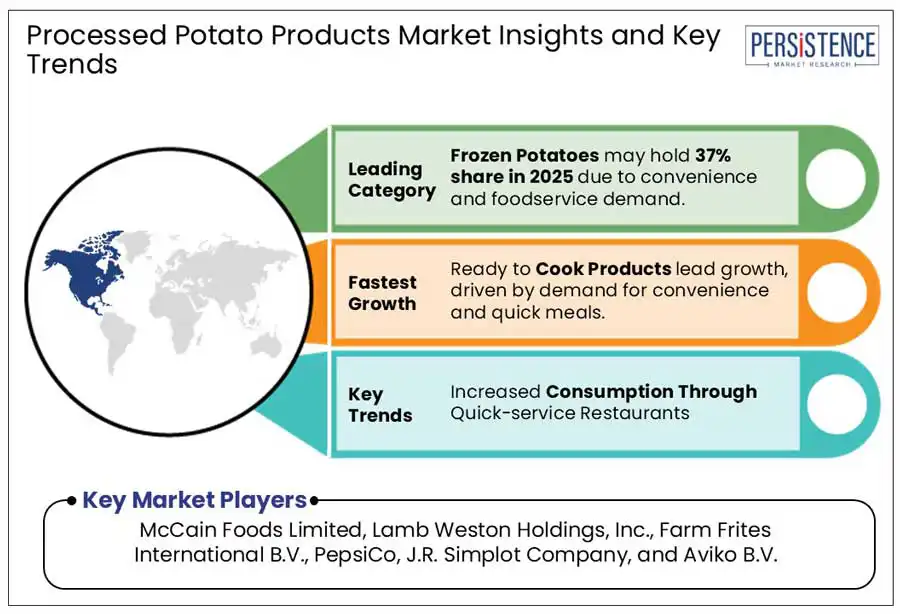Comprehensive Snapshot of Processed Potato Products Market Including Regional and Country Analysis in Brief.
Industry: Consumer Goods
Published Date: April-2025
Format: PPT*, PDF, EXCEL
Delivery Timelines: Contact Sales
Number of Pages: 150
Report ID: PMRREP30824
The global processed potato products market size is anticipated to reach a value of US$ 43,036.9 Mn in 2025 to reach a value of US$ 62,190.7 Mn and witness a CAGR of 5.4% from 2025 to 2032. The industry is witnessing a steady growth, driven by the rising consumer demand for convenient, ready-to-eat foods, rapid urbanization, and the global expansion of quick-service restaurants (QSRs). The market benefits from evolving dietary preferences, increased snacking trends, and the popularity of frozen and ready-to-cook potato offerings. Technological advancements in food processing, packaging, and cold chain logistics are enhancing product quality and shelf life. North America leads the market due to established food industries and high per capita consumption, while the industry in Asia Pacific is fast-growing, fueled by changing lifestyles, growing middle-class population, and an increased access to modern retail channels.

Key Industry Highlights:
|
Global Market Attribute |
Key Insights |
|
Processed Potato Products Market Size (2025E) |
US$ 43,036.9 Mn |
|
Market Value Forecast (2032F) |
US$ 62,190.7 Mn |
|
Projected Growth (CAGR 2025 to 2032) |
5.4% |
|
Historical Market Growth (CAGR 2019 to 2024) |
4.2% |
The global food industry is expanding with better prospects owing to increasing popularity of vegan food products in well-developed regions as a result of rising health consciousness and concerns for animal welfare. Moreover, health-conscious consumers increasingly prefer healthier snacks such as olive-baked potato chips, sweet potato fries, organic potato chips, and others to suit their nutritional needs. Baked potato chips have around ~14% fewer calories and ~50% less fat than regular potato chips, making them a healthier alternative that appeals to health-conscious consumers.
Furthermore, ready-to-cook potato products such as fries and snacks are being sold with labels such as vegan or organic to increase sales. In recent years, there has been an increase in demand for organic, plant-based flavors, and clean-labelled potato products.
Primary factors limiting the market growth include the health concerns associated with processed food consumption, including high sodium and fat content, and elevated acrylamide levels found in fried potato snacks. Acrylamide is a chemical that forms in starchy foods during high-temperature cooking is considered a potential carcinogen by health authorities such as the U.S. Food and Drug Administration (FDA) and the European Food Safety Authority (EFSA). Additionally, the high cost of cold storage and transportation for frozen and chilled products poses logistical and financial challenges, especially in warmer or less developed regions.
Processed potato product suppliers also face supply chain pressures, including fluctuations in raw potato availability due to seasonal factors, weather variability, and geopolitical issues. For example, extreme weather events in top-producing regions such as the U.S., can significantly impact crop yields and disrupt processing schedules making it difficult to maintain a consistent, year-round supply at stable prices.
The increasing consumer preference for convenience foods significantly propels the market. This surge is driven by urbanization and busy lifestyles, leading to a higher demand for ready-to-eat and easy-to-prepare food options. Processed potato products, such as frozen fries and potato chips, align well with this trend due to their convenience and versatility. Additionally, the supply-chain industry in Asia Pacific is experiencing notable growth in the processed potato products market, fueled by urbanization and changing dietary habits. These factors collectively create substantial opportunities for expansion within the processed potato products sector.
Frozen potatoes lead the processed potato market due to strong demand from quick-service restaurants (QSRs) and changing consumer habits. In the U.S., one-third of all potatoes are processed into frozen products 85% as French fries, two-thirds of which are used by QSRs. Their long shelf life and easy preparation make them ideal for fast-paced lifestyles. The share of potatoes consumed as frozen has grown from 27% in the 1970s to 44% in recent years (USDA). Global adoption of Western diets also boosts demand with China accounting for 22% of global frozen potato consumption.
The ready-to-cook (RTC) goods dominate because of rising urbanization, time restrictions, and changing consumer tastes. The need for quick meal solutions is being driven by the expanding working-age population in nations like India, which is expected to reach 65%. This trend was further driven by the COVID-19 epidemic, as more people sought out convenient yet high-quality meal options by cooking at home. RTC items that provide organic or preservative-free options are often preferred by health-conscious consumers. Furthermore, accessibility has increased due to the quick growth of e-commerce platforms, enabling a larger audience to investigate a variety of RTC goods. RTC products are now a dominant use in the processed food industry due to these combined factors.

North America leads due to its large-scale production, advanced processing infrastructure, and strong export capacity. In 2024, the U.S. processed potato products market produced approximately 418 million hundredweight (cwt) of potatoes, a significant portion of which is processed into fries, chips, and dehydrated forms to meet domestic and global demand. Canada also plays a key role, producing 5.8 million metric tons of potatoes in 2023/2024, with the majority allocated for processing. Canadian exports of French fries reached $2.7 billion in the same period, with 91% shipped to the U.S. This integrated North American supply chain supports the region’s continued dominance in the market.
Europe's significant production capabilities and thriving processing sector support its dominant position in the market. Germany contributed 21.2% (11.7 million tonnes) of the 55.3 million tonnes of potatoes harvested in the European Union in 2020. Notable for their substantial processing activities, the Netherlands led the world in 2023 with a production value of €3.11 billion, while Belgium grew by 8.54% annually. Together, these nations have created a flourishing sector that not only satisfies significant domestic demand but also establishes Europe as a major supplier of processed potato goods around the world.
?Asia is one of the regions with the fastest rates of growth in the market for processed potato products due to increased affluence, fast urbanization, and changing dietary patterns, With an estimated 95.5 million metric tons harvested in 2022 more than 20% of the world's total China leads the world in potato production. In FY 2023, India produced over 59.7 million metric tons of potatoes, ranking among the world's top producers in South Asia. The growth of fast-food franchises and shifting customer habits in these areas are driving up demand for processed and handy food items. With its robust export potential and processing skills, Oceania especially Australia contributes as well.
The global processed potato products market is marked by the presence of established global players and regional producers. Companies focus on innovation, product diversification, and sustainable processing methods to gain a competitive edge. Strategic partnerships, capacity expansions, and new product launches are key approaches to strengthen market positioning.
|
Report Attribute |
Details |
|
Historical Data/Actuals |
2019 - 2024 |
|
Forecast Period |
2025 - 2032 |
|
Market Analysis Units |
Value: US$ Mn, Volume: As applicable |
|
Geographical Coverage |
|
|
Segmental Coverage |
|
|
Competitive Analysis |
|
|
Report Highlights |
|
|
Customization and Pricing |
Available upon request |
By Type
By Application
By Distribution Channel
By Region
To know more about delivery timeline for this report Contact Sales

The global market is estimated to increase from US$ 43,036.9 Mn in 2025 to US$ 62,190.7 Mn in 2032.
Rising demand for convenience foods, expanding foodservice industry, urbanization, and evolving consumer preferences drive the global processed potato products market.
The market is projected to record a CAGR of 5.4% during the forecast period from 2025 to 2032.
Opportunities include rising demand for ready-to-cook foods, product innovation, health-focused offerings, e-commerce expansion, and growing consumption in emerging markets.
Major players include McCain Foods Limited, Lamb Weston Holdings, Inc., Farm Frites International B.V., PepsiCo, J.R. Simplot Company, Aviko B.V., and Others.